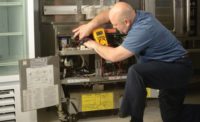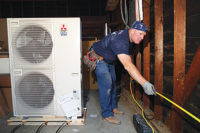After several tough years, there are some signs that the economy may finally be picking up steam. Associated Builders and Contractors Inc. (ABC) reported that the nation’s nonresidential construction spending increased 0.3 percent in December 2012, with year-over-year total nonresidential construction spending up 1.2 percent. The trade group predicts that nonresidential construction spending will expand 5.2 percent in 2013.
On the residential side, the U.S. Census Bureau announced that for 2012, overall building permits increased 30.3 percent and housing starts grew 28.1 percent. The National Association of Home Builders (NAHB) is forecasting that single-family starts will grow 22 percent in 2013 and that single-family construction will grow another 30 percent in 2014.
Contractors such as Bobby Ring, president and CEO, Meyer & Depew Co. Inc., Kenilworth, N.J., and Air Conditioning Contractors of America (ACCA) chairman, believe these signs point to a positive year ahead. “I think that the residential replacement market will continue to be strong and that commercial replacement will begin to show signs of life, as the postponed backlog of work can’t be put off much longer.”
Commercial Growth
The commercial market has been taking a repair-rather-than-replace approach for quite some time, but Ring believes this is changing. “We had a very strong January in commercial replacement, and I believe it is a sign that businesses have decided that they’ve put off replacing older systems long enough. They know that it’s time to take action to prevent prolonged and costly breakdowns, as well as improve energy efficiency.”
James P. Bartolotta, executive vice president, Air Comfort, Broadview, Ill., and board member of Mechanical Service Contractors of America (MSCA), agrees that commercial work will continue to be a bright spot this year. “For the last few years, we’ve seen owners and managers start reinvesting in their properties. They had previously been deferring maintenance, because they wanted to cut expenditures, so it’s a good sign that they’re now doing the major 10-year chiller overhauls.”
Bartolotta credits the company’s robust service base and long-time clients for its success, even throughout the economic downturn. “We were slightly affected by the economy, but the revenue from our strong concentration of preventive maintenance (PM) agreements carried us through the lean times. In fact, last year was one of the best years we have ever had. We experienced a nice gain in total revenue, and the bulk of that was through our service-agreement clients, additional repairs, and project work developed from those clients. We are also starting to see more equipment being replaced rather than repaired.”
Bartolotta believes this will be another strong year for commercial/industrial work, and he is forecasting a 10 percent growth in sales for the company’s service group. To achieve that goal, two additional service salespeople have been hired, and a targeted marketing strategy has been put into place. “Every month we’re doing something unique and creative to try and open new doors on the service-agreement side. For example, one marketing piece outlines, on average, what our clients have spent over and above the price of their maintenance agreement. We can show that for every dollar they invest in maintenance, they spend only 80 cents on the dollar for repair work on that same equipment, which is well below the industry average of around $2.50.”
A Rise in Residential
The residential replacement market is also becoming stronger, with sales at Meyer & Depew increasing 21 percent in 2012. Ring said he is projecting 20 percent growth in 2013. “We’ve hired additional salespeople and technicians, and have seen substantial additional revenue from the sale and installation of automatic stand-by generators [which were in demand after Hurricane Sandy]. We also have an aggressive marketing plan.”
Sales have also been picking up at Welsch Heating & Cooling Co., St. Louis, stated company president, Butch Welsch. “Since mid-2011, we turned a corner, and during 2012, we were quite profitable. Things have been so good, in fact, that last August we hired an additional residential replacement sales engineer, which is working out extremely well.”
While Welsch noted that sales are better due to more customers opting for replacement over repair, he said that fundamentally restructuring the company provided the biggest boost to the bottom line. “We did not react quickly enough after the downturn of 2008. We didn’t reduce our overhead or our direct workforce fast enough. In addition, half of our work at that time was residential new construction. Since then, we’ve reduced our overhead and changed the focus of our business. Previously we were a new construction contractor doing some service and replacement work; today we are a service and replacement contractor that also does some new construction.”
Restructuring was also in order at Thomas & Galbraith Heating and Cooling, Cincinnati, where business dropped off following the expiration of various federal tax credits in 2010. Over the last two years, company owner and president, Michael Weber, modified the company’s cost structure and reduced planned expenditures in order to make ends meet. “Our customers are still being very cautious with their pocketbooks, and I don’t see that improving a whole lot this year, especially once people start to experience increases in their Social Security and other taxes.”
As a self-described eternal optimist, though, Weber has decided to take some bold steps to change the focus of his company. “We are making a significant investment in home-performance contracting, because we need to add other products and services to our portfolio. We are moving forward aggressively, and we’re not going to sit back and let the economy dictate our success.”
Challenges Remain
Even an optimist such as Weber has some concerns about issues he will confront in the year ahead, though. He believes that the availability of dry-shipped R-22 units will continue to hurt the industry, although their impact may be lessened by the rising cost of R-22. “These units do not follow the intent of the law, which was to transition to R-410A. We do not offer dry-shipped units, because we believe R-410A is the way of the future.”
Weber is more concerned about the spiraling costs of health insurance. “Even with low exposure and few issues in our group, our price this year is 20 percent more than it was last year, and it was a similar increase the year before. We don’t have 50 employees, so technically we don’t fall under the Obamacare mandate, but private insurance companies are passing on the costs to us. I fear what the price will be a few years from now, because neither our company nor our employees can afford to keep up with that sort of increasing cost.”
Ring also wonders how Obamacare will affect the benefits that are offered to employees, as well as how those changes will affect the relationship with employees. “I think the biggest question that all businesspeople are faced with is, what will the federal government’s role be in the business community? How will changes in tax policy and things like card check impact our companies?”
Ring has a number of additional concerns, such as the HVACR industry’s lack of business skills training. “You come into this industry from either the briefcase or the toolbox. Those who come from the briefcase quickly realize that they need folks with the toolbox skills on their team to be successful. However, many of those who come into the business from the toolbox aren’t always as quick to realize that they need someone with the briefcase skills to help them reach success. These contractors seem to think the best way to grow their business is to have the lowest price. They don’t understand the relationship between markup and margin and think that breaking even is covering their direct costs.”
To break this cycle, Ring would like to see the industry adopt a curriculum and certification program to help contractors with on-going business concerns, and ensure they remain successful and viable. Welsch noted that to be successful, those in the industry must also look the part. “I am still appalled at the appearance of so many heating and air conditioning contractors. We are professionals in our industry, and like professionals in other industries, we should give that impression. Too many industry representatives wear dirty uniforms or T-shirts with torn jeans and a baseball cap. We are professionals, let’s look and act like it.”
SIDEBAR: The Need for Speed
Now more than ever, clients demand an enhanced sense of urgency and information, said James P. Bartolotta, executive vice president, Air Comfort, Broadview, Ill. With iPads and smartphones giving consumers instant access to information on the Internet, the expectation is that they can find information right away and just about anything can be delivered immediately.
“Customers want responses immediately,” said Bartolotta, who also serves as a Mechanical Service Contractors of America (MSCA) board member. “When they place a service call, they expect immediate feedback and communication as to when the tech will be there. Their expectations have changed, and we must utilize technology to comply with this expectation. We continue to dissect our entire process, from the initial service call to the time we collect, to figure out how we can speed up our process.”
While this technology is beneficial, it is also driving down the price of goods that are purchased by consumers, which affects how much contractors can charge. “Consider how much cheaper plasma TVs are now compared to three years ago,” said Bartolotta. “Customers think the same should hold true for our services. I hear from facility managers that they’ve had a preventive maintenance agreement with us for five years now, so the cost of the agreement should go down, not up. But our cost to do business — the raw costs, the labor, the health and welfare benefits, the union benefits, the cost of gasoline — continues to climb in a market where our clients want to pay less for our services. There’s a bit of disconnect, and it’s imperative that we demonstrate the value of our services. By performing a thorough maintenance inspection, we are, in fact, reducing the total operating cost of their facility.”
With clients facing the pressure of reducing costs, many contractors are being asked to hold the line on their preventive maintenance agreement prices, or in some cases, decrease them without changing the level of service. That is one of the biggest challenges for Bartolotta. “Not a week goes by that I don’t get a call from a commercial client who wants to renew their contract, if we’ll take 5 percent off the price and hold it there for three years. And they want the same scope, services, and technicians as before.”
When this happens, Bartolotta stressed that it is incumbent upon his company to communicate that lowering the price (and potential service level) can have a devastating effect on facilities, costing them much more in the long run. “Cutting back on these critical services, in some cases, can lead to higher energy costs, additional repairs, and possibly lower life expectancies for the equipment. As their trusted partner, we must remind them of these risks, as well as the potential hazards of simply selecting the lowest price agreement without diligently looking at what (and who) is behind the numbers.”
Publication date: 3/18/2013








